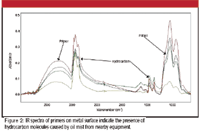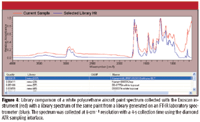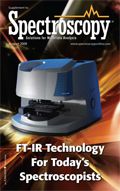Handheld FT-IR Spectrometers: Bringing the Spectrometer to the Sample
This article focuses on the emergence of handheld, portable FT-IR spectrometers and the implications with respect to applications and use.
The maturity of analytical technology tends to follow two major paths: More capability with advanced features and greater performance, or smaller, less expensive, and easier to use. The former path tends to represent the evolution of today's laboratory instruments, whereas the latter path leads to instrumentation being used out of the laboratory, by a different type of end-user.
Fourier transform–infrared (FT-IR) spectroscopy is a well-established analytical technology. In the past decade, FT-IR spectroscopy has made the leap from the laboratory to at-site applications in less traditional environments. This article focuses on the next evolutionary leap that FT-IR spectroscopy is undergoing — the emergence of handheld, portable FT-IR spectrometers and the implications with respect to applications and use.
Evolution of FT-IR Spectroscopy in Nontraditional Applications
During the 1980s, FT-IR spectroscopy became more widely accepted by personnel in QC/QA and analytical laboratories in a wide range of industries. A number of factors helped to cause this expansion of interest. Instruments became smaller, less costly, and less complicated to use. In addition to improvements in optics and electronics, the emergence of the personal computer influenced FT-IR spectroscopy. Manufacturers were able to capitalize on the economies of scale provided by using widely available computers, and a broader range of users were able to adapt to these systems rapidly because of the intuitive nature of the software.
Another important driver for the widespread adoption of FT-IR spectroscopy was the development of sampling technologies that opened up a much broader range of applications. IR spectroscopy sampling moved from the classic preparation in potassium bromide pellets and Nujol mulls, to methods that allowed for the examination of neat samples with little or no preparation. These latter methods included internal reflectance (attenuated total reflectance [ATR]), diffuse reflectance, and FT-IR microscopy.
Thus, FT-IR spectroscopy saw rapid growth as a valuable, routine laboratory method used by personnel who required quick information and answers.
During the 1990s, FT-IR spectroscopy began to be used in applications and environments that were considered more nontraditional. For example, process FT-IR spectrometers, which could withstand the rigorous environment imposed by the manufacturing plant, were introduced. Concurrently, FT-IR spectroscopy began to be "rediscovered" by organic chemists and chemical engineers to aid in the development of complex chemistry in process development and process engineering facilities. For example, chemical engineers found that the integration of in-situ FT-IR spectroscopy and reaction calorimetry provided critical information about reaction heat flow, composition, and mass balance.
To support these latter applications, new FT-IR sampling technology was required. In the mid-1990s, the diamond ATR and diamond ATR probe were developed. This technology permitted FT-IR internal reflectance spectroscopy to be carried out in chemically aggressive solutions that would have destroyed conventional ATR crystals. Due to its inertness and resistance to scratching, the diamond ATR sampling interface became a widely used sampling technology that made FT-IR amenable to an extremely broad range of applications.
The transition of FT-IR spectroscopy from the traditional laboratory to manufacturing and development laboratories was well under way during this period. It also became clear that rugged, smaller, easier-to-use, and less costly systems had great potential and appeal.
Starting in 2000, portable FT-IR systems were developed for applications such as forensic investigation of illegal drug laboratories; for assisting United Nations weapons inspectors in Iraq in their search for weapons of mass destruction; and for helping emergency responders to identify a wide range of potentially hazardous substances. These applications proved that portable FT-IR spectroscopy could be deployed effectively in challenging environments by nontraditional users.
The success of these portable FT-IR spectrometers for dedicated, nontraditional applications led to the next step in this branch of FT-IR evolution, the development of systems that are even smaller, lighter, easier to use, and less costly — the handheld FT-IR instrument. As an example, the Exoscan handheld FT-IR system (A2 Technologies, Danbury, Connecticut) was developed for surface analysis of metals and composite materials in cooperation with companies involved in commercial aviation manufacturing.
Considerations in the Development of a Handheld FT-IR Spectrometer
Optical Design, Size, and Packaging
The operating goal for a handheld FT-IR spectrometer is to employ the system at the analysis site. This is particularly true when the object to be analyzed is too large to bring to the laboratory or too valuable or too difficult to remove a sample. This implies that a handheld FT-IR spectrometer will likely be used in environments where ambient conditions are a significant factor. Thus, the instrument design must take variables in temperature, humidity, and vibration into consideration. Equally important is the nature of the sample to be analyzed, the type and responsibility of the operator, and how the system actually will be used. The latter point is critical because, for example, a handheld FT-IR spectrometer must demonstrate stability and reproducible performance in virtually any physical orientation.
Obviously, the size of the optics is a major consideration, and there are tradeoffs. If the optics are too large, the overall package can be unwieldy. However, performance might be compromised if the optical system is too miniaturized. The type of application for which the system will be deployed is an important driver for the decision about the tradeoff between performance and size. For surface analysis of composites and metals, the system must perform at a level equivalent to or better than traditional analytical FT-IR spectrometers. In the Exoscan system, this is accomplished by minimizing the internal optical path while maintaining a large beam aperture, thereby ensuring that the optical throughput of the system meets the requirements of the application. The instrument's optical system and electronics weigh approximately 2 lb, and the overall system weight, including internal battery and data system, is approximately 6 lb.
Thus, the handheld spectrometer must be rugged, insensitive to vibration, capable of handling temperature fluctuations, and not affected by motion or position. System optics must be aligned permanently, requiring no external adjustments, and designed so that the overall system remains stable, with consistent performance.
The Interface to the Sample
A handheld FT-IR instrument will likely address a wide range of sample types. The samples might be liquid, solid, or semisolid. They might be highly colored, opaque, reflective, or highly absorbing. But in all cases, the nature of the analysis implies that no sample preparation is required. The sampling interface must be versatile, yet the sampling optics must be integrated to provide maximum throughput with minimum impact on the overall system size.
Because of the applications that the Exoscan instrument addresses, two different sampling systems were developed. For hard surfaces or surfaces that are reflective, such as metal and composites, an external reflectance interface is used. For samples that are slightly softer or nonreflective, such as paints or polymers, a diamond internal reflectance interface is used. These two interfaces are user interchangeable with bayonet-type mounting to eliminate the requirement of realignment when the sampling interfaces are exchanged.
The User
A handheld FT-IR spectrometer will be used by at least three types of users, all with different skill sets and different responsibilities. One group of users will be scientists who are responsible for developing and validating methods that are to be deployed on the system. These individuals are well trained in spectroscopy and require software that enables them to develop a variety of methods including sample identification methods, quantitative methods using univariate or multivariate algorithms, and methods that define whether an article is acceptable or unacceptable for use. The methods might be executed by personnel who likely will be untrained in spectroscopy and are using the handheld FT-IR system to acquire specific information. The type of information that these users require might be presented in a "pass–fail," "yes–no" format or as a specific value that is indicative of the performance of a sample. These users require the system to operate intuitively, with simple push-button operation. The information that the operator obtains must be easily transferable to another type of user, the supervisor, who is responsible for certifying or otherwise validating information from the system as well as verifying that the FT-IR system is operating correctly.
Examples of Handheld FT-IR Applications
The potential range of applications for a handheld FT-IR spectrometer is quite broad. Some of these applications include: analysis of materials such as polymers and composites; determination and quantification of surface contaminants and surface quality; identification and measurement of coatings, including paints, primers, and films; and general identification of a broad range of liquids, solids, and semisolids that are used in the manufacture of chemicals and chemical-based products. The following examples are applications that a high-performance, handheld FT-IR spectrometer can accommodate.
Analysis of Damage to Composite Materials Caused by Heat, Environmental Oxidation, and Chemicals
The Exoscan instrument was developed in collaboration with companies in the aircraft industry, and the requirement of analyzing black, medium modulus, graphite fiber resin composites was one of the drivers for the performance and sampling interface design.
Because composites are organic materials, they are susceptible to environmental stressors that potentially can weaken the composite material. For this reason, there is significant interest in nondestructive analyzers that can determine the condition of in-service composite materials.
Analyzing composites via FT-IR requires some special considerations. In fiber-rich, resin-poor regions of the composite, the amount of IR radiation being reflected by the sample is highly attenuated by the carbon fiber, so it is very important that the performance of the spectrometer is optimized. An external reflectance sampling interface is required, enabling the spectrometer to analyze the resin component of the composite for molecular changes caused by exposure to a variety of stressors.
As an example, the system was used to analyze cured composite samples that were heated for 1 h at 25 °F intervals starting at 300 °F (Figure 1). The IR spectra of the heat-treated composite samples show increasing growth of an ester–perester type carbonyl species, and additional ketone–carboxyl groups as the thermal treatment temperature increases. These changes are indicative of significant oxidation, which results in weakening of the composite matrix. The IR absorbance bands associated with aromatic polyethers (PEEK) and polysulfones (PSF) are observed to diminish greatly in the 350–500 °F temperature range. These PEEK and PSF composite resin bands are observed to inversely correlate quite well with the treatment temperature. The loss of these functionalities is indicative of a weakening of the resin bonds, which in turn affects the overall strength of the composite.

Figure 1
Contaminants on Surfaces and the Effect on Bonding and Coating
Successful bonding and coating of metal or composite materials is highly dependent upon how the surfaces to be joined or coated are prepared and cleaned. With FT-IR spectroscopy, residual contaminants can be detected and identified, and the levels present can be measured.
Contaminants can be entrained in primers that are applied to surfaces. Oil from fingerprints and machinery (Figure 2), amount of water present in the primer, and humidity of the ambient environment can affect the primer performance. These contaminants are readily detected by FT-IR spectroscopy. Also, silicone mold release is important in composite fabrication, but residual silicone is a troublesome contaminant with respect to bonding and coating processes. Fortunately, silicone contaminants, from a variety of sources used during the production of metal and composite parts, are detected by FT-IR spectroscopy.

Figure 2
Oxide Layers Metal Surfaces
Metals such as aluminum often are given an oxide coating via anodization to minimize corrosion. There are different methods for anodizing metal, and each produces different chemical structures on the metal surface and different physical properties. Handheld FT-IR spectroscopy readily elucidates these different anodized surfaces to ensure that the proper surface treatment has been applied, and provides the amount, thickness, and uniformity of the anodized coating.
As an example, five samples of 2024 aluminum were treated with borate sulfuric acid anodization and measured with the handheld FT-IR instrument (Figure 3a). The aluminum oxide surface concentration ranged from 66 to 374 mg/ft2. The strong aluminum–oxygen stretching band observed at 1128 cm–1 shows good correlation with concentration of surface oxide layer (Figure 3b).

Figure 3
As a result of ambient temperature and humidity conditions, unintended oxidation of metal surfaces can occur as well. This thin layer of oxidation can significantly affect follow-on steps required to coat, paint, or prime a surface. Handheld FT-IR spectroscopy can detect this unwanted oxidation and provide a measurement of the amount present.
Paint, Primer, and Adhesive Identification, Homogeneity, and Thickness
The design documentation for many aircraft specifies paints of a particular composition. These paints are selected for durability, weight, weather resistance, and ultraviolet resistance. In addition, primers are specified for their particular bonding characteristics. Often, articles will arrive either primed or painted from outside vendors. Nondestructive FT-IR analysis can be used to verify the composition of these paints and primers on full parts and eliminate the need to disassemble or otherwise destroy expensive parts for first article inspection.
For example, epoxy paints and primers, as well as urethane paints, were identified on aluminum parts with the handheld instrument. Though libraries can be created using the instrument's software, in this particular study a library generated using a conventional laboratory FT-IR system was searched. The samples of aircraft epoxy paint were measured using the diamond ATR sample technology, and the spectra were collected in approximately 4 s. Figure 4 shows an excellent match between the unknown paint measured by the handheld instrument and the library spectrum measured on the laboratory FT-IR spectrometer, verifying that the correct paint was used.

Figure 4
By analyzing the molecular structure of paints and primers, FT-IR can differentiate different paint and primer formulations. A handheld instrument with an onboard library can verify that the proper material has been applied to a surface as well as indicate the uniformity and thickness of the surface coating.
Conclusion
This article has provided a perspective on the evolution of FT-IR technology over the past 30 years. The scientists and engineers who have been involved over this period have participated in the growth of a highly valuable and interesting technique. Each person likely would write the history differently, based upon their own experience, but we would all likely agree on the outcome, that FT-IR spectroscopy continues to be an exciting technology with great growth potential driven by new, commercially valuable applications. The advent of handheld FT-IR spectroscopy now offers even greater opportunity for expansion into new applications, markets, and industries.
Alan Rein is Vice President, Business Development, with A2 Technologies, Danbury, Connecticut.

AI Shakes Up Spectroscopy as New Tools Reveal the Secret Life of Molecules
April 14th 2025A leading-edge review led by researchers at Oak Ridge National Laboratory and MIT explores how artificial intelligence is revolutionizing the study of molecular vibrations and phonon dynamics. From infrared and Raman spectroscopy to neutron and X-ray scattering, AI is transforming how scientists interpret vibrational spectra and predict material behaviors.
Real-Time Battery Health Tracking Using Fiber-Optic Sensors
April 9th 2025A new study by researchers from Palo Alto Research Center (PARC, a Xerox Company) and LG Chem Power presents a novel method for real-time battery monitoring using embedded fiber-optic sensors. This approach enhances state-of-charge (SOC) and state-of-health (SOH) estimations, potentially improving the efficiency and lifespan of lithium-ion batteries in electric vehicles (xEVs).
New Study Provides Insights into Chiral Smectic Phases
March 31st 2025Researchers from the Institute of Nuclear Physics Polish Academy of Sciences have unveiled new insights into the molecular arrangement of the 7HH6 compound’s smectic phases using X-ray diffraction (XRD) and infrared (IR) spectroscopy.